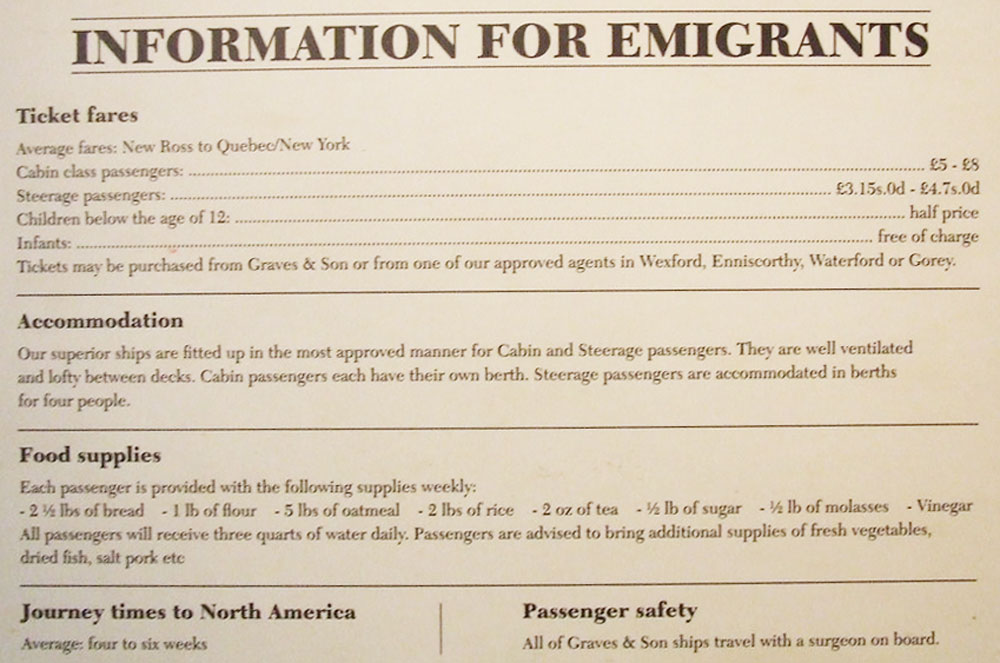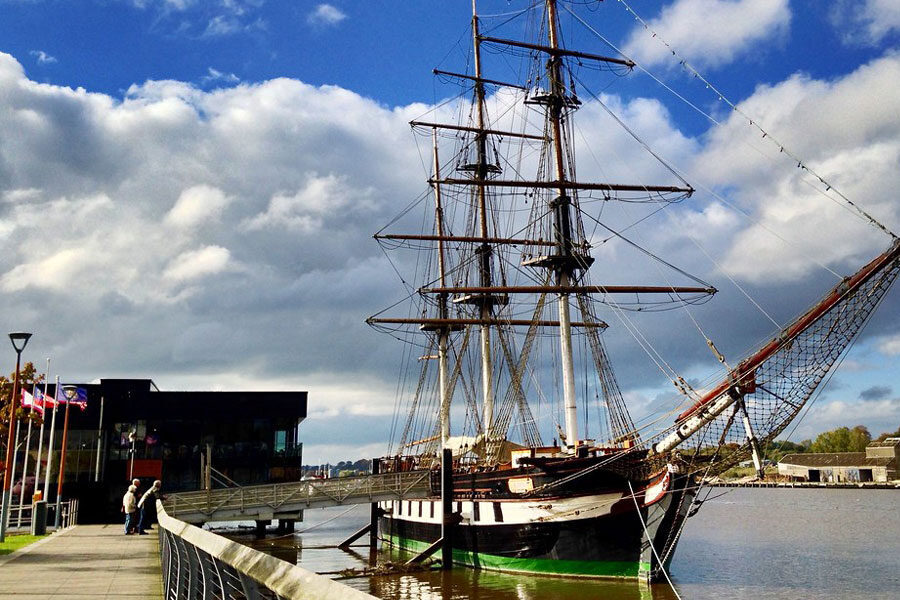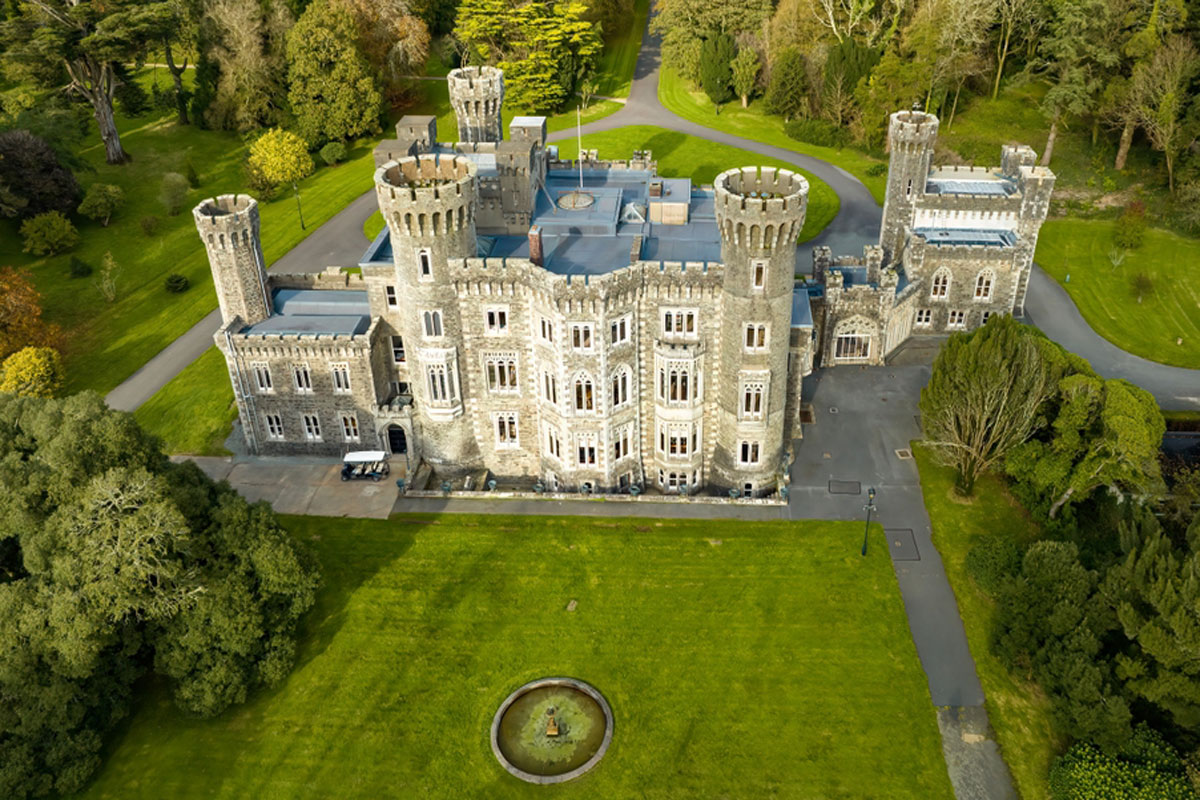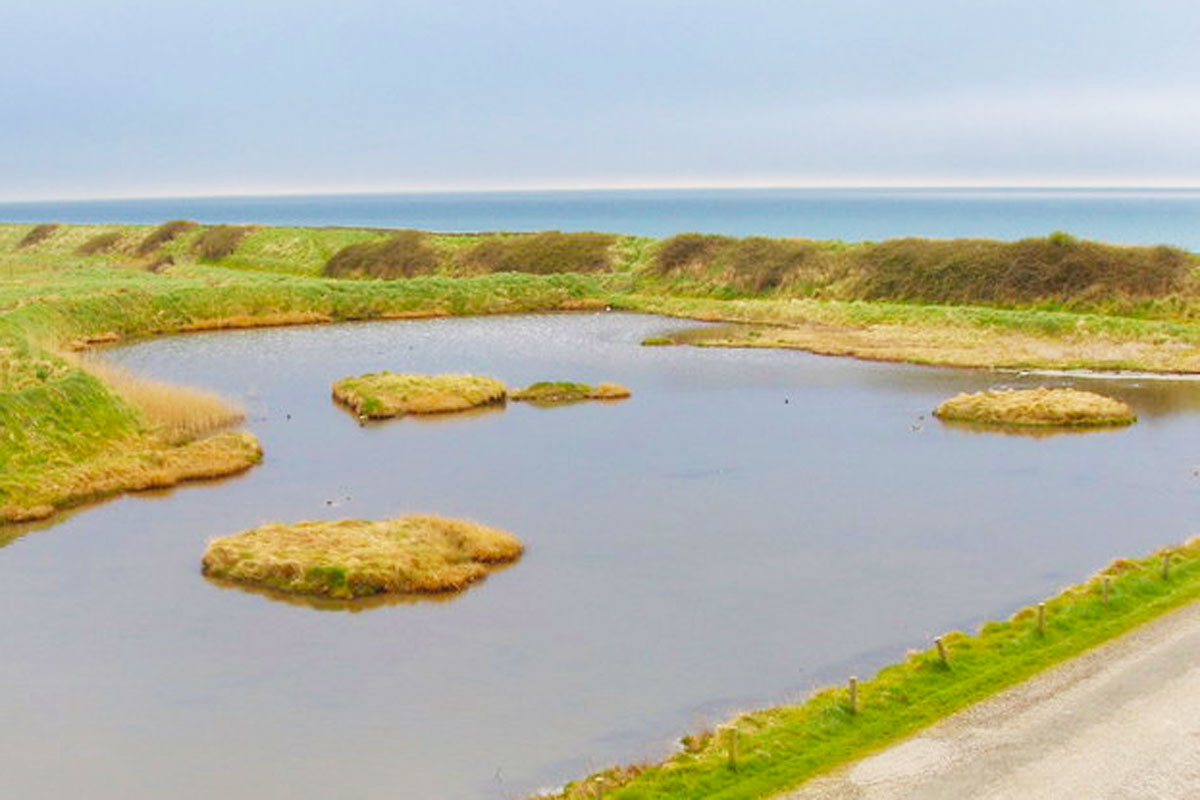A Trip Through Time
The Dunbrody Famine Ship, an imposing presence against the seaside scenery, invites tourists to venture over its threshold and travel through time. This ship is more than a vessel; it is a portal that leads us into the heartbreaking story of the Great Famine—a moment in Irish history replete with misery, courage, and human endurance.
The aroma of the water seems to convey whispers from decades past as we approach the ship’s aged wooden decks. The creaking of the timbers beneath our feet and the ship’s rhythmic sway take us to a time when emigrants went on a perilous journey, leaving behind familiar shores in search of hope and survival.
With each stride, we close the time deficit. The present is supplanted by eerie echoes of the past. The Dunbrody Famine Ship, painstakingly restored to reflect the conditions of the time, acts as a living link connecting us to the experiences of individuals who previously walked these decks.
We become historical pilgrims, retracing the steps of countless people who dared to dream of a better life over the sea. The ship’s rustic appearance—its wooden frame weathered by time, its rigging standing against the sky—evokes a bygone period. It represents a people’s unbreakable spirit in the face of great adversity.
The sea air carries more than salt and mist; it brings the whispered stories of emigrants who clung to their dreams in the face of life’s storms. We become time travelers when we cross the doorway of this vessel, traveling to a period that moulded the very fabric of Ireland’s character. The Dunbrody Famine Ship is more than just an exhibit; it’s an interactive experience that goes beyond the present and deep into history.
We can almost hear the whispered conversations of families huddled together, seeking solace in one another’s company, in the shadows of the ship’s hold. The flickering light throws long shadows, symbolizing the journey of people who previously gathered there, their hopes and worries contrasting sharply with the chilly uncertainty of the sea.
We invite the past to direct our steps and mould our understanding as we embark on our journey through time. The Dunbrody Famine Ship is a vessel of memory, transporting stories of pain and fortitude across generations. With each step, we remember those who risked the unknown, and with each breath, we remember the tenacity that characterized a nation in the face of hardship.
The voyage has only just begun—a journey that spans time, pays homage to the human spirit, and leaves an unforgettable stamp on our hearts. We are reminded as we sail through the chapters of history on the Dunbrody Famine Ship that the echoes of the past resound inside us, moulding who we are and encouraging us to chart our own route across the seas of life.
Reenacting the Famine Period
Boarding the Dunbrody Famine Ship is more than just getting onboard a ship; it’s a step back in time. The ship transforms into a doorway that transports us to an era marked by adversity, tenacity, and resilience—the era of the Great Famine. The creaking of the wooden planks beneath our feet seems to reverberate with the voices of people who have traveled these same paths, bearing hopes and dreams as frail as the ship itself.
Every nook and cranny of the Dunbrody Famine Ship serves as a heartbreaking reminder of the hardships faced by Irish emigrants in the mid-nineteenth century. The exquisite restoration acts as a time machine, transporting us to the small living quarters, sparse furniture, and harsh realities of those who embarked on this perilous expedition. The interior of the ship is transformed into a canvas on which the tale of the Famine period is painted—a story of struggle, perseverance, and the unbreakable spirit of the Irish people.
We can almost feel the presence of folks who once occupied these identical areas as we walk through the ship’s hallways. Their hopes and anxieties, resolve and doubt, seem to be carried by the air. The gloomy lighting and rustic décor bring us to another world, immersing us in an environment that reflects the difficulties that the emigrants encountered. It’s as if time has folded in on itself, allowing us to see a chapter of history that helped define the fate of a nation.
The restoration of the ship is more than just an exhibition; it is an invitation to relive history. We pause to consider the families that shared these places, the parents and children who gathered close in quest of comfort and warmth. The modest furnishings—basic bunks, common cooking areas—speak to the resourcefulness required to manage an uncertain journey.
We can’t help but think about the emotional weight of the emigrants’ decisions as we walk over the ship’s deck. Each step brings us closer to comprehending the agonizing decisions made by those who fled their homes in quest of survival, hope, and opportunity. The wind carries the echoes of their whispered chats, as well as the laughter and tears that would have mingled with the sea breeze during their journey.
The Dunbrody Famine Ship becomes a generational bridge. It connects us to our ancestors’ experiences, reminding us of their sacrifices and the legacy they left behind. We are given the opportunity to walk in their shoes, even if only for a short time, to obtain a better understanding of the struggles they surmounted and the strength they displayed in the face of adversity.

An Interactive Journey
The Dunbrody Famine Ship is more than just a museum exhibit trapped in time; it’s a living history museum that invites visitors to walk in the footsteps of those who came before us. As we board this painstakingly restored ship, we are taken back to an era that dictated the path of Irish history: the Great Famine. The interactive character of this encounter distinguishes it, transforming passive observation into active engagement.
Visitors are more than just viewers; they are participants in a time travel adventure. The ship’s deck becomes a stage for history to unfold, and we become characters in a multigenerational story. Walking through the replicated cabins provides insight into the tight and difficult living conditions these emigrants faced. The furniture’ simplicity, close quarters, and shared rooms provide a genuine view into the reality of living aboard the ship.
As we touch the rough-hewn wood, our senses are engaged, creating a tactile connection that bridges the gap between past and present. Under our fingertips, we can practically feel the textures of the past—the textures of tenacity, survival, and hope. We are experiencing history as we explore the ship, feeling the echoes of the emigrants’ sufferings and hopes reverberate through us.
The option to interact with the ship’s guides, who are dressed in historical attire, is one of the pleasures of this interactive experience. Their stories bring history to life by providing unique insights into the lives of those who fled their home countries in quest of a brighter future. We obtain a better understanding of the individual stories that make up the wider tapestry of the Famine Era through their narratives. Their evocative descriptions bring historical events to life, helping us to empathize with the emigrants’ struggles and achievements.
Even though the ship is firmly docked, we can’t help but sense its sway as we go through its hallways. This modest movement enhances the experience by immersing us in the sensation of life at sea. It’s as if the ship is gently prodding us to envision the journey—the excitement, uncertainties, and hopes that transported the emigrants over the ocean.
This interactive tour is an exercise in empathy, encouraging us to explore the decisions made by people who set out on this difficult journey. We can practically hear hushed conversations, children’s laughing, and quiet moments of introspection. It’s an opportunity to walk alongside history, to build a relationship that goes beyond facts and dates, and to recognize the human stories at the heart of the Famine era.
A Living Memory
As we step off the Dunbrody Famine Ship and onto firm ground, we are leaving behind more than just a wooden vessel—we are leaving behind a time machine that has taken us through the annals of history. The ship’s hold contains more than just exhibits; it also carries the murmurs of countless individuals who left their imprint on Ireland’s history. It is more than a museum; it is a living memory, a vessel of connection that spans time and distance.
The Dunbrody Famine Ship’s impact stays like a melody, playing slowly in the hallways of our minds. Its significance grows as we consider the remarkable journeys of those who formerly sailed on its decks. We find ourselves retracing their steps, picturing the faces of families saying their final goodbyes, the sound of waves crashing against the hull, and the hope that must have shined in their eyes despite the gloom surrounding them.
This ship becomes a canvas onto which we imprint stories of human resilience and fortitude. It contains the sacrifices made by previous generations, evolving into a vessel of remembrance that bears the weight of their hopes, sufferings, and desires. We immersed ourselves in their world with every step we took on its deck, seeing the past through their eyes and hearts.
County Wexford, located in Ireland’s sunny southeast, is celebrated for its golden beaches, historic landmarks, and rich cultural heritage. Here’s a guide to its most notable tourist attractions:
Historical and Cultural Sites
- Hook Lighthouse: The world’s oldest operational lighthouse, offering guided tours and breathtaking views of the coastline.
- Irish National Heritage Park: An open-air museum showcasing 9,000 years of Irish history with reconstructed ancient sites.
- Dunbrody Famine Ship: A replica famine ship in New Ross that tells the story of emigration during the Great Famine.
- Tintern Abbey: A picturesque 12th-century abbey with beautiful woodland walks nearby.
- Johnstown Castle Estate, Museum & Gardens: A stunning Gothic Revival castle with lakes, gardens, and an agricultural museum.
Natural Attractions
- Curracloe Beach: A pristine Blue Flag beach famous for its appearance in Saving Private Ryan.
- The Raven Nature Reserve: A coastal forest offering peaceful walks and opportunities for birdwatching.
- Saltee Islands: A haven for birdlife, particularly puffins, and accessible by boat from Kilmore Quay.
- Ballymoney Beach: A family-friendly spot with golden sands and clear waters.
- Bannow Bay: A tranquil estuary with a rich history and stunning views.
Scenic Drives and Villages
- Kilmore Quay: A charming fishing village with traditional thatched cottages and access to the Saltee Islands.
- Enniscorthy: A historic town featuring Vinegar Hill, Enniscorthy Castle, and a vibrant arts scene.
- Wexford Town: The county capital known for its medieval streets, opera festival, and friendly atmosphere.
- New Ross: A riverside town famous for the Dunbrody Famine Ship and the JFK Homestead.
- Gorey: A bustling market town with excellent shopping, dining, and proximity to beaches.
Lakes and Water Activities
- River Slaney: Perfect for kayaking, fishing, and riverside walks.
- Lake at Johnstown Castle: A serene setting for leisurely strolls and picnics.
- Kilmore Quay Marina: Ideal for boating, fishing, and exploring the nearby Saltee Islands.
- Bannow Bay: A peaceful spot for kayaking and enjoying scenic views.
- Rosslare Strand: A popular destination for swimming, surfing, and other water sports.
Unique Experiences
- Wexford Opera House: Home to the annual Wexford Festival Opera, renowned for its world-class performances.
- Kennedy Homestead: The ancestral home of JFK’s family, showcasing his legacy and Irish roots.
- Hook Peninsula Drive: A scenic route with stunning coastal views and historic sites like Duncannon Fort.
- Loftus Hall: Ireland’s most haunted house, with eerie tales and ghost tours.
- Ballycross Apple Farm: A family-friendly attraction offering seasonal apple picking and homemade treats.
County Wexford combines natural beauty, historical significance, and vibrant culture. Whether strolling along Curracloe Beach or exploring the heritage of the Hook Peninsula, Wexford promises a diverse and enriching experience for every visitor.
Helpful Resources






